You may not find this terribly rewarding unless you're included here, so this is a good time for casual and random browsers to turn back before they get too caught up in the sweep and majesty of the proceedings and can't let go.
No visit to Lisbon is complete without a stop-in at Belém. Two, actually.

We're quickstepping down, at a reasonable hour, towards the mighty Tagus, 30 October 2017.

Striding past the Jardim do Príncipe Real, but looking across the street

Fancy a tandoori; or a pizza?

Having spent a while looking for the Gloria elevator down the hill, finally we've found it, the Ascensor da Glória -- not an elevator at all as it turns out but a funicular rail track. But we're already at the bottom of it now.

We've missed our chance.

The city's tribute to the paving-stone men, a thoughtful gesture, near the Praça dos Restauradores

"SALE OFF" -- Shotguns, 'revolwers', pistols, ammo, all the accessories for hunters; fencing supplies

The roasted chestnuts season

Lisbon street scene (the Bank Totta & Açores until 2000, now the Banco Santander Totta, Rua Áurea)
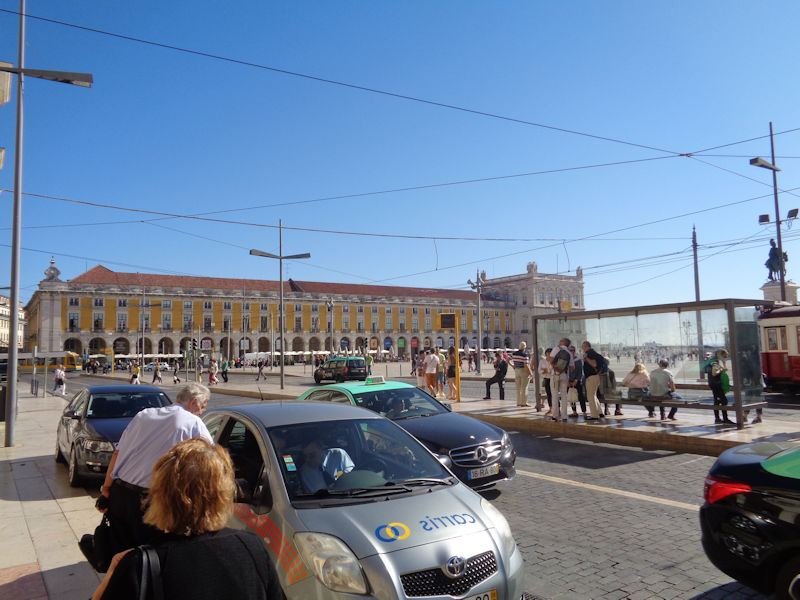
We're emerging onto the huge riverside Praça do Comércio.

The Arco da Rua Augusta, or Augusta Street Arch, begun as part of the 1st Marquis of Pombal's reconstructions of the devastated city after the earthquake of 1755, originally as a belltower but by 1873 as the archway with its allegorical 7m crown on the top in its present form. The four statues above the columns represent historical luminaries, including Vasco da Gama and the 'Constable' Nuno Alvares Pereira, with Pombal himself on the right.

From the Arch looking north up the Rua Augusta pedestrian shopping axis -- Pombal's plan marked out the wreckage of the entire low-lying area into a modern grid pattern some 300m wide and stretching 500m back to the Praça Rossio near the main rail station.

The riverside Praça do Comércio or Commercial Square, literally a square over 150m on a side

Graced by an equestian statue of King José I. Dom José (1714-1777) was a great fan of the opera and 'assembled one of the greatest collections of operatic scores in Europe'. When he succeeded to the throne in 1750, he effectively turned the administration of Portugal over to the Marquis of Pombal. His experience of the 1755 earthquake left him with a serious case of claustrophia and he lived out the remaining two decades of his reign in tents.

King José's statue features a big horse, which makes sense for an equestrian statue -- the elephants, maybe not so much. And the people being crushed underfoot, not at all.

The impressive Praça do Comércio. The buildings flanking the arch are home to the Ministry of Justice on the left and the Supreme Tribunal court on the right.

Actually we're here to find some public transport 6 or 7km westward to Belém near the point where the Tagus River can arguably be called the Atlantic Ocean. We've consulted tourist trams and tuk-tuks for a while, but instead we'll take a taxi.
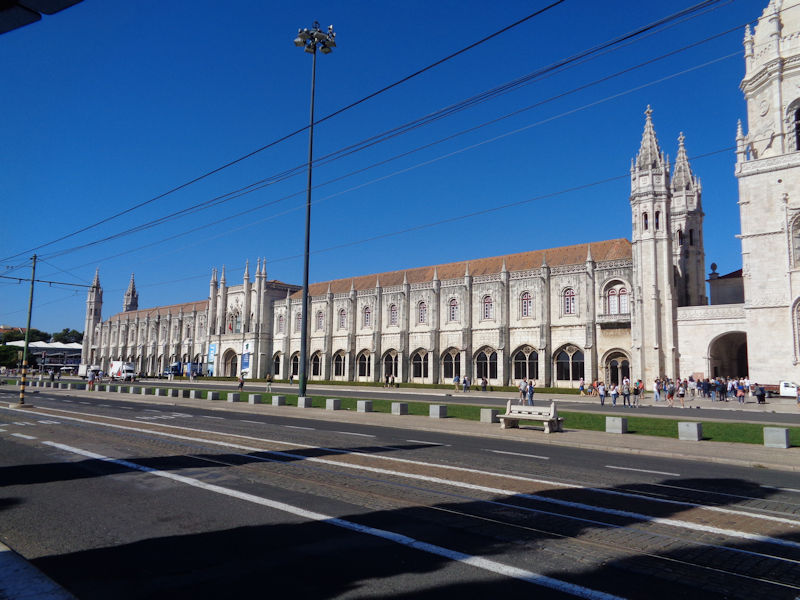
This is the Mosteiro dos Jerónimos or Hieronymites Monastery, once a property of the Order of St Jerome, a strict eremetical order founded in the 14th century -- the building was begun in 1501, after King Manuel I secured permission from the 'Spanish Pope' Alexander VI Borgia, on the site of an earlier church dedicated to the Virgin Mary belonging to the Military Order of Christ.

Renovations in progress. The Order of Christ of warrior-monks had been founded in 1319 by King Dinis I from the remnants of the recently disbanded Knights Templar, and here their mission was to minister to the spiritual requirements of the seamen passing to and from the Lisbon and Restelo/Belém docks on voyages of trade and exploration.

King Manuel's main objective for the new church and monastery was to provide sepulchral housing for himself and his royal Aviz dynasty and, importantly, to house monks who would pray for the souls of the king and his kin forever (they got as far as the dissolution of the religious orders in 1833) -- but he also included that original purpose of providing pious attention to the navigators and sailors leaving from the Restelo port here at Belém in particular.

OH NO! It's Monday. No tourism on Mondays!

We get to see the amazing western main door to the church in the alley between it and the monastery, as we wait about a bit in the hope that a charitable monk with the keys might wander by and let us in. But there haven't been any monks here for 184 years.
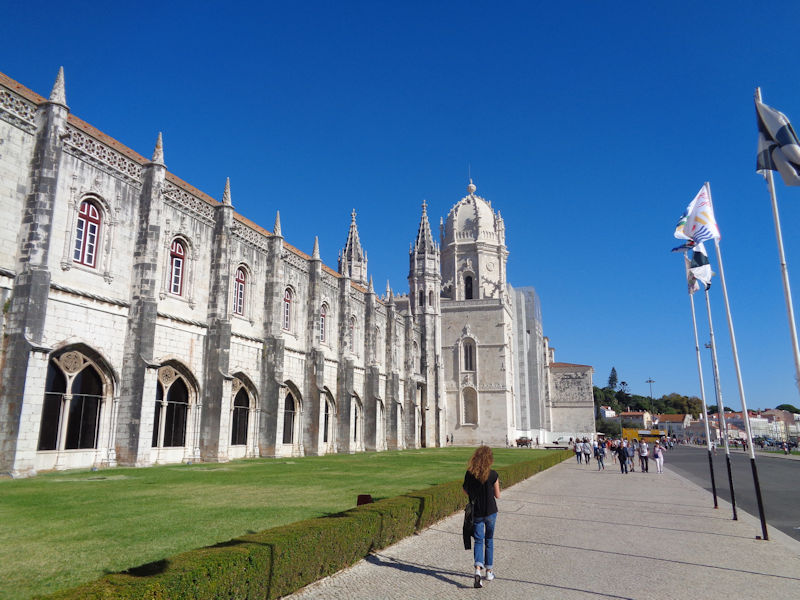
We're walking around in a black mood, looking for something else to amuse us.

The façade facing the river, three American football fields long
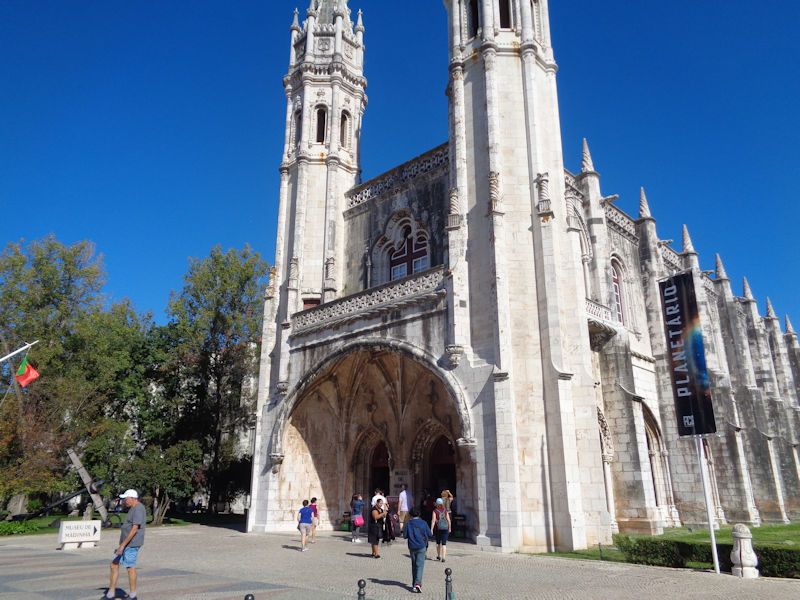
Here we are at the western door of the monastery, now leading into the Museu de Marinha or Maritime or Naval Museum.

What better place for the curious tourist to contemplate maritime history than in the home port of the explorers of the Golden Age of Portugal's Age of Discovery.

Portugal was a European leader in overseas explorations, with expeditions locating the Canary Islands and Azores and mapping the western coast of Africa incrementally from 1419 under the sponsorship of Prince Henry 'the Navigator' (1394-1460, third son of King John I and Philippa of Lancaster) and afterward.

Portuguese achievements continued without Henry, including the rounding of the African Cape of Good Hope in 1488 and Vasco da Gama's establishing a potential trade route in western India in 1498.

Vasco da Gama's flagship (model)

A succession of models illustrating the evolution of early seagoing ships, in this case the caravel with lateen sails

And this formidable 16th century galleon

The 'Indiaman' carrack the Madre de Deus, commissioned in Lisbon in 1589, was returning from India with a fabulous cargo when, intercepted off the Azores, it was captured by an English squadron commanded by Walter Raleigh and George Clifford, the Earl of Cumberland, in the 'Battle of Flores', 1592, and brought back to Dartmouth. After which it was mobbed by looters, who divested the ship of an astronomically large amount of valuable cargo until Raleigh was able to secure the docks. It's assumed that the ship itself was renamed and put into English service. [Portugal had been annexed by Spain in 1580 and so the ship was fair game for the English, just four years after the attempted invasion of the Spanish Armada.]

The museum's collection of 17,000 items grew out of the vision of King Luis I in the 1860s, but they were established here in the western wings of the monastery in 1963. According to Lisbon Tourism, 'The mission of this museum is to keep alive the memory of the great naval achievements of Portugal starting from the age of the great geographical discoveries until now.' (This would hardly be the place to bring up the brutal slave trade and vicious colonial trade exploitation that ensued, until the 1970s.)

Portuguese naval officers (i.e., just mannequins in uniform)

An early bowsprit (so much for the topless mermaids)
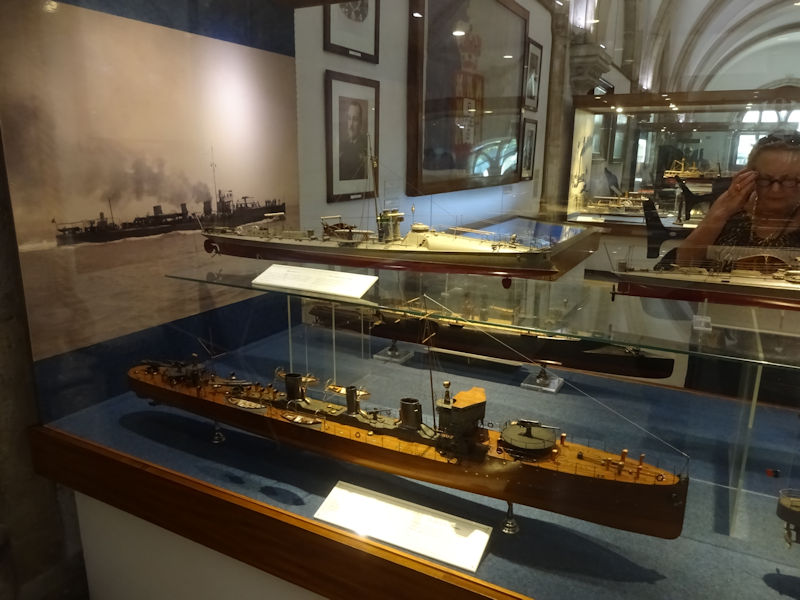
A sample of the modern ships on display

Some modern boats look like routine ocean-going warships, but quite a few look more like up-river machine-gun boats for various policing activities.

Another long monastic corridor full of memorabilia, like steering wheels, deck-mounted machine guns, and so on

A delicate description of the War in the Overseas. '1974 put an end to a conflict that lasted for more than fourteen years.' Right.

We've had enough, to be honest, of model ships and military uniforms, but we don't want to miss the special Viking exhibition on offer at the moment.

'Vikings - Warriors from the sea' is a temporary exhibition, April to 12 November 2017 (we just made it), comprising 600 artifacts from the National Museum of Denmark. Moorish Portuguese towns and monasteries certainly had frequent memorable experiences with the mostly Danish Viking raiders in the 9th to 11th centuries, but there was also a history of 13th century dynastic marriages and 15th century naval collaborations between the two countries.

A Viking ship
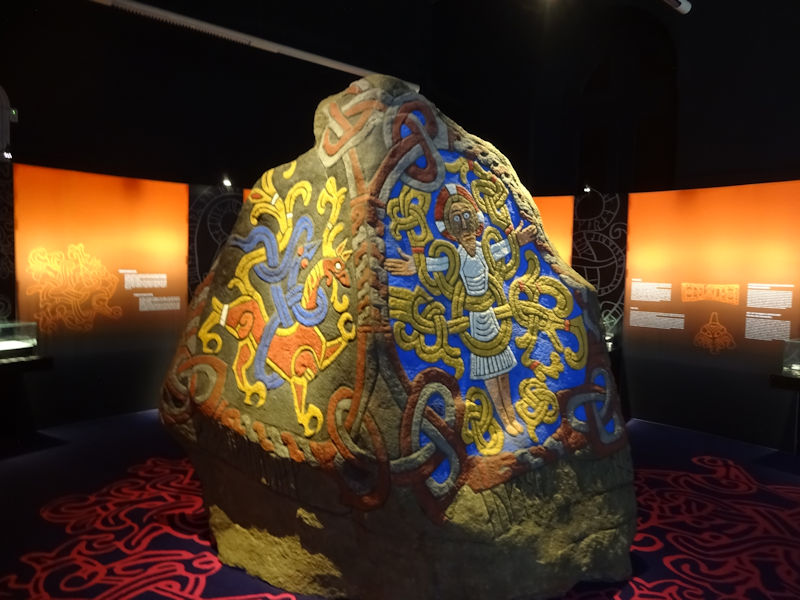
A replica of the 'Jelling Stone', with carved runes celebrating Harald Bluetooth's conquest of Denmark and (briefly) Norway and his decision to Christianize the Danes in the latter 10th century.

We're back outside, in a large square at the western end of the monastery. The rusty monument of sorts is filled with artillery shell or shrapnel holes.


The western entrance to the former monastery and to the Maritime Museum

We're off to visit the town of Belém itself. For lunch.

The entrance with the ticket office, and no line for tickets

Downtown Belém for a nice, small lunch, and then back down to business

The monastery and church across the Jardim da Praça do Império, the garden of the Imperial Square. We're bound now for the famous Torre de Belém, about a kilometre along the riverfront highway to the west.

The passerelle over the N6 thoroughfare (the 4-lane Av. de Brasília on the left, the 4-lane Av. da Índia below, and tram tracks between them).

Weeel's frozen yogurt van at the end of the footbridge staircase

A bronze airplane -- 'Sacadura Cabral and Gago Coutinho Monument' (first flight across the South Atlantic, Lisbon to Rio de Janeiro, 1922).

The Torre de Belém

Wine with a View
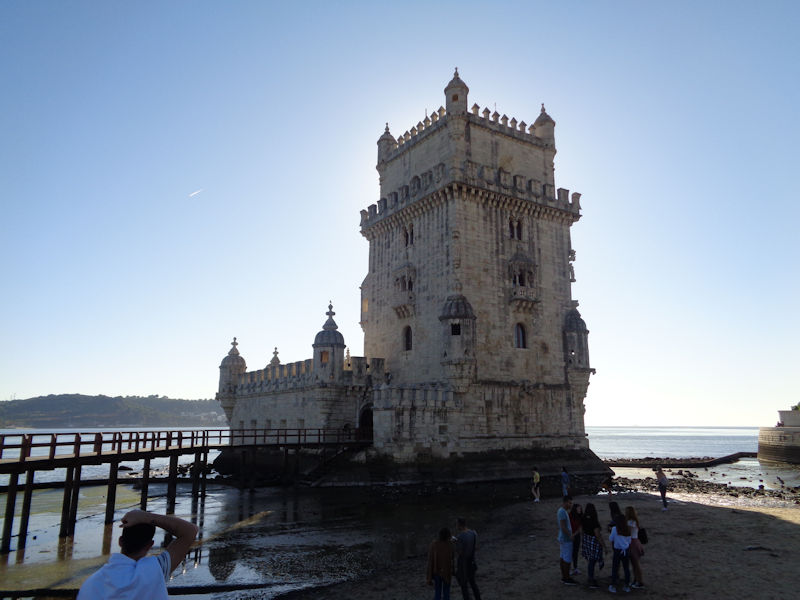
The Belém Tower, or 'Tower of St Vincent', was ordered up by King Manuel I and completed in 1519. There were artillery defenses farther out at the mouth of the Tagus river, but they could not cover the width of the river, so the present fortification is built upon a rectangular bastion as a defensible artillery platform.

The architectural style is described as basically 'Manueline', but with moorish elements and later additions.

The fort was strengthened in the 1570s, but nevertheless the garrison surrendered under a brief siege by the Spanish in 1580. Thereafter the dungeons were employed as a prison, then as a military barracks during the French occupation of Lisbon 1808-1814, and then as a prison again when King Miguel I needed to remove his liberal opponents from the political scene. The whole thing was restored in the 1990s and has been a UNESCO World Heritage site since the '80s.

It was originally built on that tiny island -- we seem to be here at low tide. And since it's a Monday, no photos of the interior.

When you can't get into the Tower, you need to find something else fun to be getting on with.

The Tower and a ship passing out of the Tagus Estuary
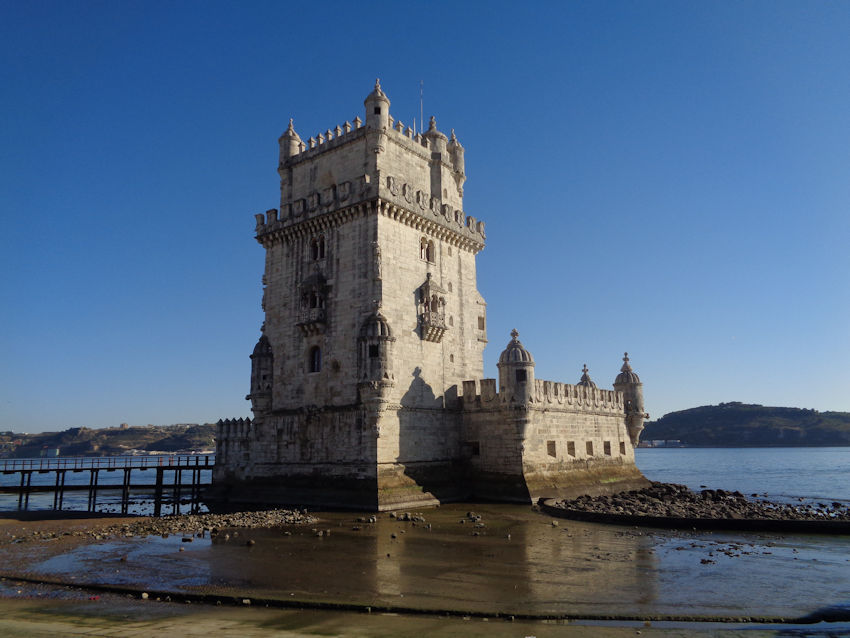

It's a disappointment, not be able to get in there today -- perhaps another time.

Our taxi ride back downtown, under the Ponte de 25 Abril
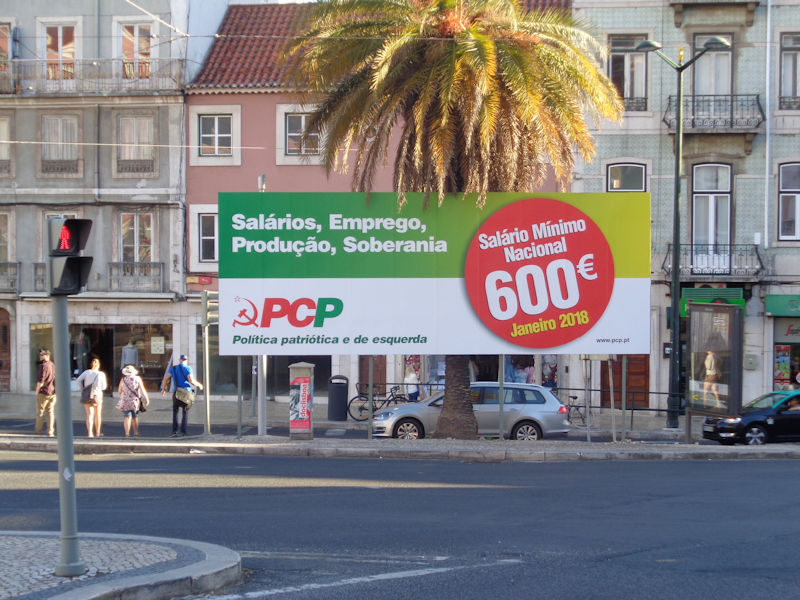
Worthy sentiments -- a minimum national salary of €600, monthly presumably, in an upcoming referendum. Trust the Communist Party to be out front on the important social issues.
Tomorrow: Back to Belém for another go.








 Dwight Peck's personal website
Dwight Peck's personal website































































